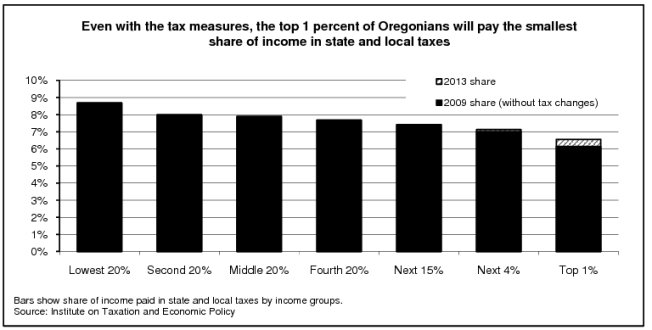Oregon faces a severe fiscal crisis. In short, the state is just not taking in enough money to fund all the services needed by people. In response the 2009 Legislature passed two measures (66 and 67) that will raise $733 million in new revenue in the 2009-11 biennium. While not a solution to the crisis, this extra money will help reduce cuts in spending on education, health and public safety. These measures also help produce a more equitable tax structure.
In brief, Measure 66 raises taxes on high income Oregonians—couples earning over $250,000 a year and individuals earning over $125,000 a year. Measure 67 raises taxes on profitable corporations. (More details on both measures here).
Perhaps not surprisingly, there are those that oppose any tax changes, even ones as important, needed, and justifiable as these. They succeeded in putting these measures on the January ballot, hoping to get voters to reject them.
One of their arguments is that the tax increases are unfair. But really what is unfair is the unbalanced nature of our existing tax system (see table below). For example, as the Oregon Center for Public Policy explains:
Today, low-income Oregonians pay a larger share of their income in state and local taxes than wealthy Oregonians. In fact, the highest-income Oregonians pay the lowest share of their income in state and local taxes. . . . After accounting for the deduction of state income taxes on federal tax returns, the lowest-income Oregonians currently pay 8.7 percent of their income in taxes, the highest share among all income groups. Middle-income Oregonians pay 7.9 percent. The wealthiest 1 percent — households with income in excess of $410,000 and averaging over $1 million — pay only 6.1 percent of their income toward state and local taxes.
The passage of Measure 66 will help move things in a more equitable direction:
The lowest-income Oregonians will still pay the same 8.7 percent of their income in state and local taxes, but the share will increase for those at the highest levels of the income scale. For the wealthiest 1 percent, for example, state and local taxes will increase from 6.1 to 6.6 percent of their income. For the next highest 4 percent of taxpayers, taxes will increase from 7.0 to 7.1 percent of income. These slight changes for those at the top 5 percent of the income scale constitute a small but important step toward making our tax system better based on ability to pay.

Other opponents are calling these measures “job-killer tax increases,” especially Measure 67. The recently established Oregonians Against Job-Killing Taxes (OAJKT) argues that “Oregon government doesn’t even need the new taxes. They already have the money sitting in bank accounts.” Their website says that if the measures are defeated “no services have to suffer.”
In a recent Oregonian column, Steve Duin examines those behind the OAJKT effort to overturn Measures 66 and 67. He concludes as follows:
As Chuck Sheketoff at the Oregon Center for Public Policy noted, these riffs are necessary because only 3 percent of Oregonians will pay higher taxes if Measures 66 and 67 pass. . . .
Tis the season. I’ll end with this. The OAJKT website insists that “the most damaging” tax increase for business would require that a C-corporation with $25 million-$50 million in Oregon sales will now pay a gross sales tax of $30,000.
That’s all? Less than one-tenth of 1 percent? For many companies that, for years, have paid the $10 minimum? Who in the world considers that unreasonable?
A number of economists teaching and working in Oregon have recently published a statement in defense of Measures 66 and 67. You can read it here.
